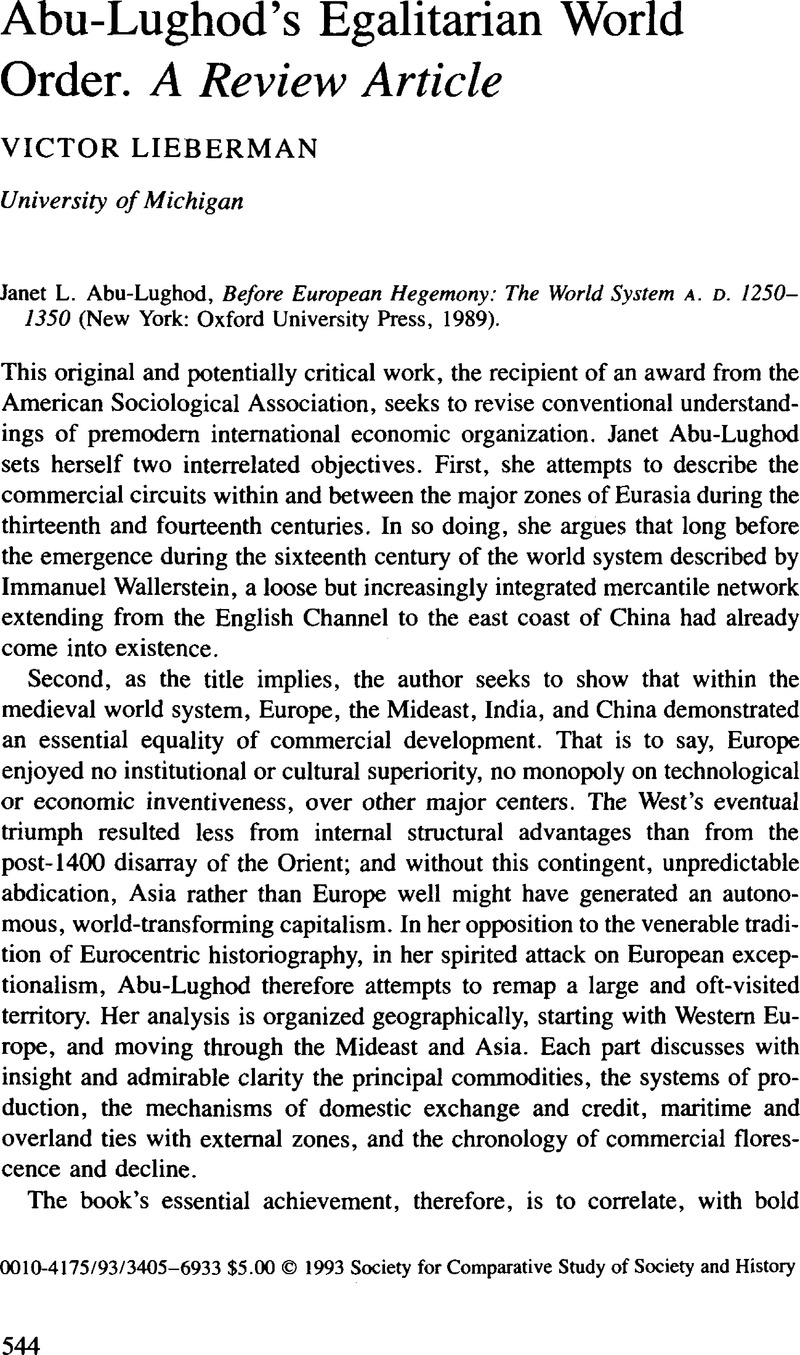Article contents
Abu-Lughod's Egalitarian World Order. A Review Article
Published online by Cambridge University Press: 03 June 2009
Abstract

- Type
- The Imperial State in the Middle Ages
- Information
- Copyright
- Copyright © Society for the Comparative Study of Society and History 1993
References
1 Wolters, D. W., Early Indonesian Commerce (Ithaca, 1967)Google Scholar and The Fall of Srivijaya in Malay History (London, 1970)Google Scholar are both cited in the bibliography, but Wolters’ arguments are at variance with Abu-Lughod's conclusion on p. 360.
2 “Forces of Regional and State Integration in the Western Archipelago, c. 1500–1700,” Journal of Southeast Asian Studies, 18: 1 (1987), 24–44CrossRefGoogle Scholar, and “Royal Authority and the Orang Kaya in the Western Archipelago, Circa 1500–1800,” Journal of Southeast Asian Studies, 17: 2 (1986), 256–67CrossRefGoogle Scholar.
3 “The Structure of Cities in Southeast Asia, Fifteenth to Seventeenth Centuries,” Journal of Southeast Asian Studies, 11: 1 (1980), 235–50CrossRefGoogle Scholar; idem, Southeast Asia in the Age of Commerce 1450–1680 (New Haven, 1988); idem, “An ‘Age of Commerce’ in Southeast Asian History,” Modern Asian Studies, 24: 1 (1990), 1–30, citing secondary works available before the publication of Abu-Lughod's work.
4 A History of Malaysia (London, 1982)Google Scholar, esp. chs. 1–3.
5 See Reid, “The Structure of Cities,” n. 3.
6 Weber, Max, Economy and Society, Roth, Guenther and Wittich, Claus, eds., 3 vols. (New York, 1968)Google Scholar; idem, The Religion of China, Hans Gerth, tr. (reprint, Glencoe, III., 1968); Anderson, Perry, Lineages of the Absolutist State (London, 1979)Google Scholar, esp. notes A and B; Wallerstein, Immanuel, The Modern World-System I and II (Orlando, 1974 and New York, 1980)Google Scholar; Kennedy, Paul, The Rise and Fall of the Great Powers (New York, 1987)Google Scholar, ch. 1; Chirot, Daniel, “The Rise of the West,” American Sociological Review, 50(1985), 181–95CrossRefGoogle Scholar; Jones, E. L., The European Miracle (Cambridge, 1981)Google Scholar; North, Douglass and Thomas, Paul, The Rise of the Western World (Cambridge, 1973)CrossRefGoogle Scholar. See, too, Crummey, Robert O., Aristocrats and Servitors: The Boyar Elite in Russia 1613–1689 (Princeton, 1983), 164–74Google Scholar.
7 See Reischauer, Edwin O. and Craig, Albert M., Japan: Tradition and Transformation (Sydney, 1973)Google Scholar, chs. 2, 3: Hanley, Susan B. and Yamamura, Kozo, Economic and Demographic Change in Preindustrial Japan 1600–1868 (Princeton, 1977)Google Scholar; Smith, Thomas C., Native Sources of Japanese Industrialization, 1750–1920 (Berkeley, 1988)Google Scholar; Studies in the Institutional History of Early Modern Japan, Hall, John W. and Jansen, Marius B., eds. (Princeton, 1968)Google Scholar, pt. 1; Leupp, Gary P., “One Drink from A Gourd: Servants, Shopkeepers and Laborers in the Cities of Tokugawa Japan” (Ann Arbor: University of Michigan, Ph.D. disser., 1989)Google Scholar.
8 Elvin, Mark, The Pattern of the Chinese Past (Stanford, 1973)Google Scholar; idem, “Why China Failed To Create an Endogenous Industrial Capitalism, ” Theory and Society, 13: 3(1984), 379–91; Chao, Kang, Man and Land in Chinese History: An Economic Analysis (Stanford, 1986)Google Scholar; Huang, Philip C. C., The Peasant Economy and Social Change in North China (Stanford, 1985)Google Scholar, adumbrating some of the arguments in idem, The Peasant Family and Rural Development in the Yangzi Delta, 1350–1988 (Stanford, 1990).
9 Cf. de Vries, Jan, The Economy of Europe in an Age of Crisis, 1600–1750 (Cambridge, 1976), 9–12Google Scholar; Carlo M. Cipolla, Before the Industrial Revolution, 2nd ed. (New York, 1976), 151–5Google Scholar; Feuerwerker, Albert, “Qing Economic History and World Economic History” (unpublished manuscript, 1985)Google Scholar; Elvin, , Chinese Past, pt. 3Google Scholar.
10 On cultural, social, and also political obstacles, see Feuerwerker, , “The State and the Economy in Late Imperial China,” Theory and Society, 13: 3 (1984), 297–326CrossRefGoogle Scholar; Bergere, Marie-Claire, “On the Historical Origins of Chinese Underdevelopment,” Theory and Society, 13: 3 (1984), 327–37CrossRefGoogle Scholar; Myers, Ramon H., “How Did the Modern Chinese Economy Develop?—A Review Article,” The Journal of Asian Studies, 50: 3 (1991), 604–28CrossRefGoogle Scholar; Elvin, , Chinese Past, 286–98Google Scholar.
11 Glamann, Kristof, Dutch-Asiatic Trade, 1620–1740 (Copenhagen, 1958), 11: 244–65Google Scholar; Vries, De, Economy of Europe, 128–46Google Scholar; O’Brien, Patrick, “European Economic Development: The Contribution of the Periphery,” The Economic History Review, 35: 1 (1982), 4Google Scholar; Hobsbawm, E. J., “The Crisis of the Seventeenth Century,” in Crisis in Europe, 1560–1660, Aston, Trevor, ed. (London, 1965), 50Google Scholar.
12 Hamilton, , “American Treasure and the Rise of Capitalism (1500–1700),” Economica, 9: 27 (1929), 338–57CrossRefGoogle Scholar; Wallerstein, Modern World-System I and II; Frank, , World Accumulation, 1492–1789 (New York, 1978)CrossRefGoogle Scholar; Amin, Samir, Accumulation on a World scale, 2 vols. (New York, 1974)Google Scholar; Braudel, Fernand, “European Expansion and Capitalism: 1450–1650,” in Chapters in Western Civilization (3rd ed., New York, 1961), I, 245–88Google Scholar.
13 O’Brien, Patrick, “European Economic Development,” 1–18Google Scholar; Vries, De, Economy of Europe, esp. chs. 4, 6Google Scholar; McKendrick, Neil, “Home Demand and Economic Growth,” in Historical Perspectives: Studies of English Thought and Society in Honour of J. H. Plumb, McKendrick, Neil, ed. (London, 1974), 152–210Google Scholar. See, too, the discussion and sources cited in Price, Jacob, “What Did Merchants Do? Reflections on British Overseas Trade, 1660–1790,” Journal of Economic History, 49: 2 (1989), 267–84CrossRefGoogle Scholar.
- 2
- Cited by


